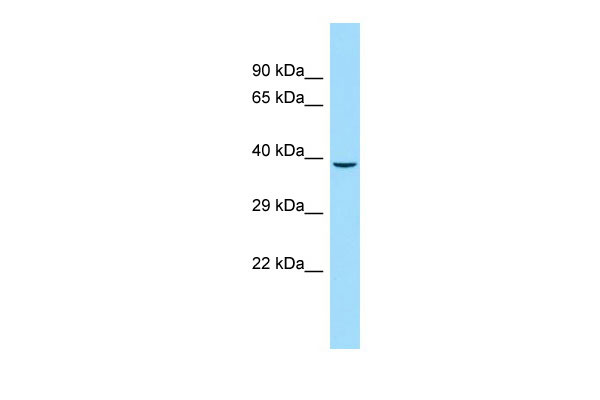GPR65 antibody - C-terminal region
Rabbit Polyclonal Antibody
- SPECIFICATION
- CITATIONS
- PROTOCOLS
- BACKGROUND

Application
| WB |
|---|---|
| Primary Accession | Q8IYL9 |
| Other Accession | NM_003608, NP_003599 |
| Reactivity | Human, Mouse, Rat, Rabbit, Pig, Horse, Dog |
| Predicted | Human, Mouse, Rat, Rabbit, Pig, Horse, Dog |
| Host | Rabbit |
| Clonality | Polyclonal |
| Calculated MW | 39kDa |
| Gene ID | 8477 |
|---|---|
| Alias Symbol | TDAG8, hTDAG8 |
| Other Names | Psychosine receptor, G-protein coupled receptor 65, T-cell death-associated gene 8 protein, GPR65, TDAG8 |
| Format | Liquid. Purified antibody supplied in 1x PBS buffer with 0.09% (w/v) sodium azide and 2% sucrose. |
| Reconstitution & Storage | Add 50 ul of distilled water. Final anti-GPR65 antibody concentration is 1 mg/ml in PBS buffer with 2% sucrose. For longer periods of storage, store at 20°C. Avoid repeat freeze-thaw cycles. |
| Precautions | GPR65 antibody - C-terminal region is for research use only and not for use in diagnostic or therapeutic procedures. |
| Name | GPR65 {ECO:0000303|PubMed:27287411, ECO:0000312|HGNC:HGNC:4517} |
|---|---|
| Function | Proton-sensing G-protein coupled receptor activated by extracellular pH, which is required to monitor pH changes and generate adaptive reactions (PubMed:15326175, PubMed:15618224, PubMed:20855608, PubMed:33478938, PubMed:37722051, PubMed:39753132). Activated by an optimal pH of 7.4 (PubMed:39753132). Ligand binding causes a conformation change that triggers signaling via guanine nucleotide- binding proteins (G proteins) and modulates the activity of downstream effectors, such as adenylate cyclase (PubMed:15326175, PubMed:15618224, PubMed:37722051, PubMed:39753132). GPR65 is mainly coupled to G(s) G proteins and mediates activation of adenylate cyclase activity (PubMed:15618224, PubMed:37722051, PubMed:39753132). May also act as a receptor for the glycosphingolipid psychosine (PSY) and several related glycosphingolipids (PubMed:11309421, PubMed:15326175). Plays a role in immune response by maintaining lysosome function and regulating T-cell metabolism (PubMed:27287411). Acts as a regulator of inflammation by mediating pH-sensing of extracellular acidification which takes place in inflamed tissues: activation regulates endo-lysosomal function of immune cells and T-cell metabolism (By similarity). Constitutively active in endosomes and stimulates adenylate cyclase production from endosomes independently from extracellular pH changes (PubMed:39753132). |
| Cellular Location | Cell membrane; Multi-pass membrane protein. Early endosome membrane; Multi-pass membrane protein. Late endosome membrane; Multi-pass membrane protein. Note=Internalizes and localizes to early and late endosomes, from where GPR65 signals at steady state, irrespective of extracellular pH (PubMed:39753132). Changes in extracellular pH may relocalize receptor signaling to the cell membrane (PubMed:39753132). |
| Tissue Location | Predominantly expressed in thymus, spleen, lymph nodes, small intestine, lung, placenta and peripheral blood leukocytes |

Thousands of laboratories across the world have published research that depended on the performance of antibodies from Abcepta to advance their research. Check out links to articles that cite our products in major peer-reviewed journals, organized by research category.
info@abcepta.com, and receive a free "I Love Antibodies" mug.
Provided below are standard protocols that you may find useful for product applications.
References
Kyaw H.,et al.DNA Cell Biol. 17:493-500(1998).
Heilig R.,et al.Nature 421:601-607(2003).
Im D.-S.,et al.J. Cell Biol. 153:429-434(2001).
If you have used an Abcepta product and would like to share how it has performed, please click on the "Submit Review" button and provide the requested information. Our staff will examine and post your review and contact you if needed.
If you have any additional inquiries please email technical services at tech@abcepta.com.













 Foundational characteristics of cancer include proliferation, angiogenesis, migration, evasion of apoptosis, and cellular immortality. Find key markers for these cellular processes and antibodies to detect them.
Foundational characteristics of cancer include proliferation, angiogenesis, migration, evasion of apoptosis, and cellular immortality. Find key markers for these cellular processes and antibodies to detect them. The SUMOplot™ Analysis Program predicts and scores sumoylation sites in your protein. SUMOylation is a post-translational modification involved in various cellular processes, such as nuclear-cytosolic transport, transcriptional regulation, apoptosis, protein stability, response to stress, and progression through the cell cycle.
The SUMOplot™ Analysis Program predicts and scores sumoylation sites in your protein. SUMOylation is a post-translational modification involved in various cellular processes, such as nuclear-cytosolic transport, transcriptional regulation, apoptosis, protein stability, response to stress, and progression through the cell cycle. The Autophagy Receptor Motif Plotter predicts and scores autophagy receptor binding sites in your protein. Identifying proteins connected to this pathway is critical to understanding the role of autophagy in physiological as well as pathological processes such as development, differentiation, neurodegenerative diseases, stress, infection, and cancer.
The Autophagy Receptor Motif Plotter predicts and scores autophagy receptor binding sites in your protein. Identifying proteins connected to this pathway is critical to understanding the role of autophagy in physiological as well as pathological processes such as development, differentiation, neurodegenerative diseases, stress, infection, and cancer.


